 |
| |
Tenerife Sur Airport – Los Abrigos – Vilaflor – Santiago del Teide – Icod de los Vinos – Puerto de la Cruz – La Laguna – San Andrés – Santa Cruz – Güimar – El Médano
(345 km)
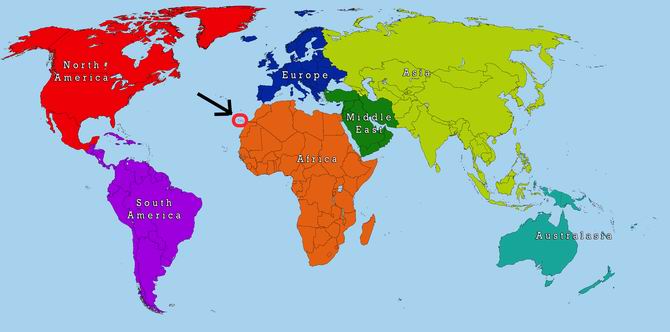 |
|
Eternal spring time, with temperatures hovering around 24°C year round, makes the Canary Islands a perfect Christmas/New Year destination. However, with visions of ugly, overcrowded resorts, Kurt wouldn’t hear tell of it. That was until Darina produced evidence of Tenerife being the training ground for Tour de France hopefuls… and he relented.
|
| | |
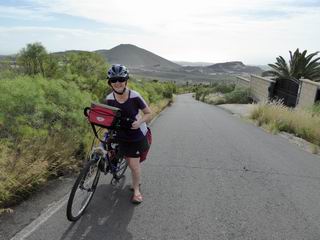
Pay back! |
To prove that she was game, Darina suggested heading up to Vilaflor on day one. Not true! This was Kurt’s idea of fun: 1,400 altitude metres over a mere 25 km.
Google maps helped with quiet roads, but at a price. Had the gradient been any steeper, we would have been cycling upside down! Nonetheless, it did avoid the busy resorts on the south/south west coast.
|
| | |
 |
 |
They’re not afraid of colours in Tenerife! |
| | |
The vegetation in the south was dry and desert like, with a variety of cacti and colourful flowers by the roadside. It wasn’t until we reached the altitude of Vilaflor that we entered pine forests.
|
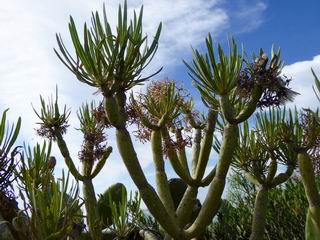
All the cacti you can dream of
|
| | |
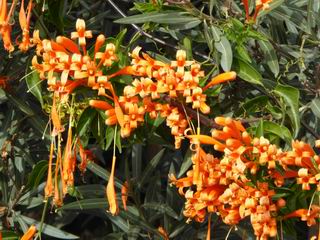 |
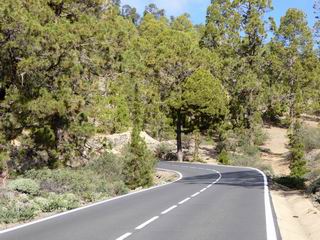 |
|
| |
| | |
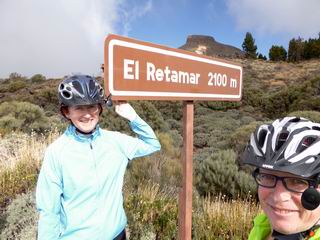
The highest point |
Day two brought us up the side of the Teide volcano, the highest mountain in Spain (3718m). After reaching the highest point of 2,100m, the road led though a desolate lunar landscape and continued through a huge lava field dating back to the last eruption in 1798. Temperatures dropped to 7°C, which is relatively mild considering other years it would have been a snowfield.
|
| | |

The Teide volcano looms ahead
|
| | |
 |
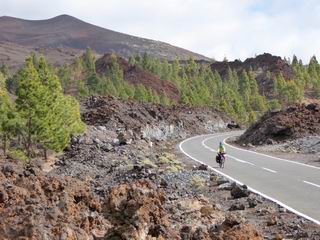 |
Lava fields from 1798 |
| | |

Teide country
|
| |
The route down to Santiago del Teide was another one that Google maps found for us. It turned out to be a strenuous mountain biking trail through pine forests and lava fields, with a rainbow thrown in for good measure!
|

The Google-maps short cut!
|
| | |

Under the rainbow |
| | |
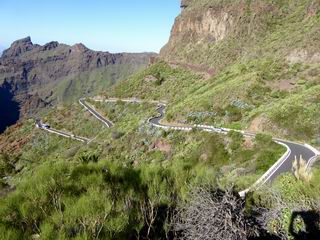
Masca hairpin bends |
The Masca valley was one of our highlights.
The dramatic road meandering through the mountains here is described by the local bike hire company as having more hairpins than a Japanese Geisha
house! After Masca village, the traffic thinned out considerably and the views continued to be just as spectacular.
|
| | |

The stunning Masca valley
|
| | |
 |
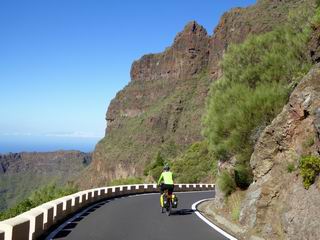 |
Views as far as La Gomera island |
| | |
On the northern coast, we enjoyed the colourful town of Garachico, cycled through banana plantations and ended up in Icod de los Vinos. This is where Kurt had his first rest day and Darina her first shopping fix! The main tourist attraction here is the
El Drago tree, whose sap turns dark red when exposed to the air. This may account for the local legend that these trees grow where dragons died.
|

View of Garachico
|
| | |

Steep inclines in Garachico |
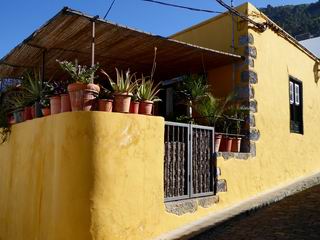
Garachico
|
| | |

Decorative wooden balconies, Icod |

El Drago tree, Icod de los Vinos
|
| | |

Street art in Puerto de la Cruz |
Christmas Eve saw us in a giant German old folks home: Puerto de la Cruz. This was really the only resort we visited on the island, but at least, it does have a real town attached to it. Darina had another serious shopping fix, while Kurt was checking out street art in the old town. It’s also the place where we suffered our
worst paella ever … but that happens!
|
| | |

Puerto de la Cruz
|
| | |
Christmas dinner in Tacoronte was a German mixed grill complete with sauerkraut and potato salad washed down with home-brewed beer. Without this international option, it could have been a weight-watchers’ day with all the local eateries boarded up.
|

Christmas dinner
|
| | |

El Sauzal |
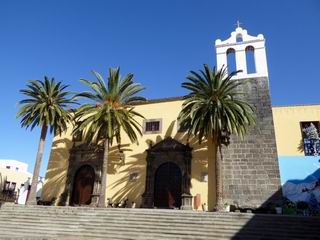
Garachico
|
| | |
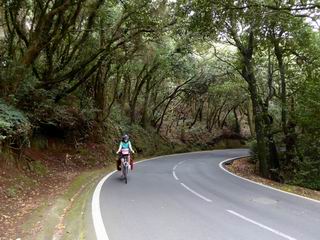
Anaga mountain range |
Anaga mountains in the northeast are pretty stunning. On a personal note, we saw the local sub-tropical cloud forest turn into a local sub-tropical rain
forest, and views were only to be had on our descent into San Andrés.
|
|
| | |
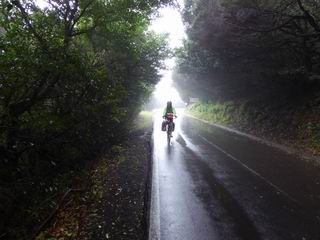 |
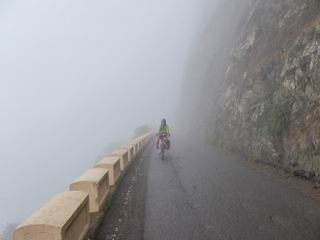 |
Sub-tropical cloud forest becomes sub-tropical rain forest! |
| | |
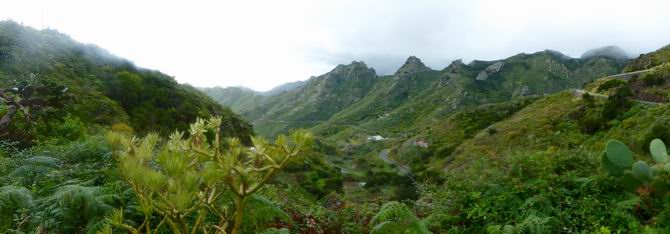
The Anaga mountain range in the rain
|
| | |
Our favourite beach was Playa de Las Teresitas
in San Andrés. Golden sand imported from the Sahara, coupled with a wave breaker makes this a beautiful, safe place for a dip. With no hotels in
town, it manages to remain relatively quiet. Most visitors are
day-trippers from the capital Santa Cruz , 11 km away, who take advantage of the numerous seafood restaurants in town. We rented a house for three days (40 euros a day) and the La Pandorga restaurant never ceased to impress.
|
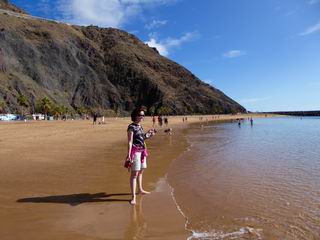
Las Teresitas beach, San Andrés
|
| | |
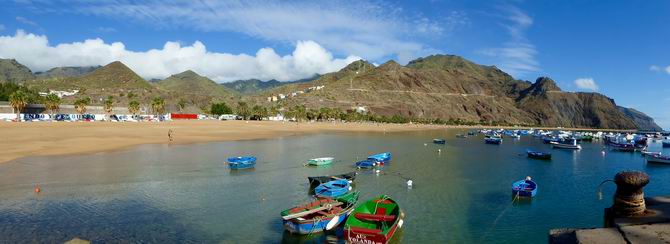
Las Teresitas beach
|
| | |
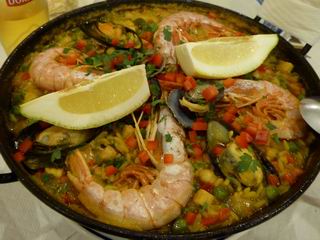
Paella |
| | |

Circulo de Amistad Xll de Enero |
In Santa Cruz, even Kurt had a shopping fix.
But to give him his due, he found a fantastic example of Calatrava architecture in the local
concert hall. Santa Cruz is a buzzing city full of pedestrian streets, plazas and parks, with a long promenade along the harbour, where
five cruise ships were docked that day.
|
| | |
 |
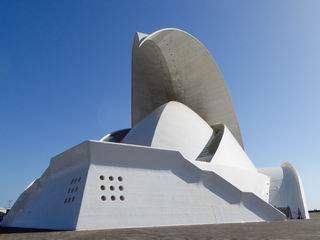 |
Calatrava’s concert hall, Santa Cruz |
| | |
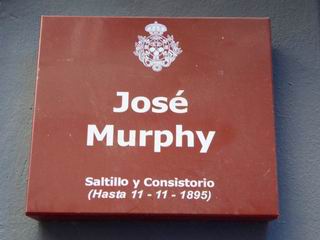
The Irish have been everywhere! |
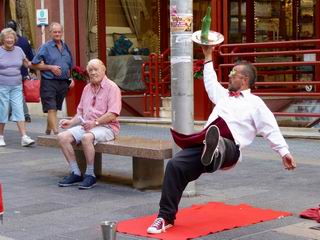
Oops! Street artist in Santa Cruz
|
| | |
Our last leg saw us cycling back to the airport on
the old TF28, a quiet scenic road leading through little villages
way above the coastal motorway. Güimar was our
half-way point and from here we had a little hike through Malpais
(bad lands) with lava dating back 10,000 years. The last stretch was touring cycling at its best: plain beautiful without being strenuous or repetitive.
|
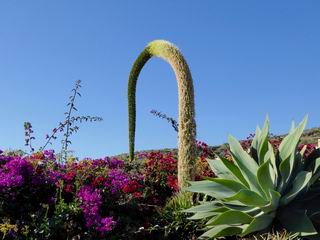
An array of colour on the TF28
|
| | |

Malpais, Güimar |
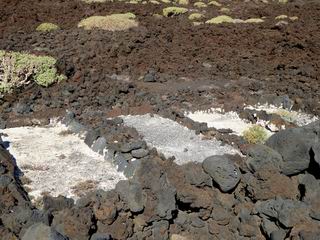
Salt flats in Malpais
|
| |

Malpais, Güimar
|
| | |

Black-sand beach, El Puertito |

On the TF28
|
| | |
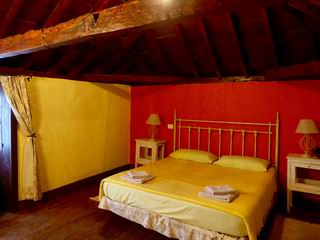
Casa Rural, Vilaflor |
Our accommodation in Tenerife varied from a
resort hotel, to hostels, to apartments to rural hotels/houses, the latter
referring to friendly run guesthouses in historical buildings, rather
than a remote location.
|
| | |

Casa Casilda, Tacoronte |

Casona Santo Domingo, Güimar
|
| | |
The food did not disappoint and there were
quite a few local specialities worth sampling. Seafood, grilled cheese
and rabbit abounded and many dishes were served with papas negras
arrugadas (small black wrinkled potatoes boiled with a serious
amount of salt). A recurring theme was mojo, a dipping sauce made of coriander/parsley or red peppers with garlic, oil and seasonings.
|
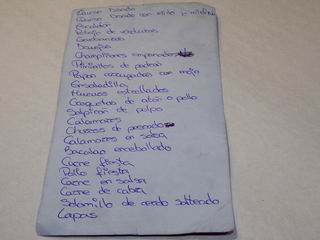
What do you fancy from this menu?
|
| | |

Mixed tapa platter |

Lapas (Limpets with coriander mojo)
|
| | |
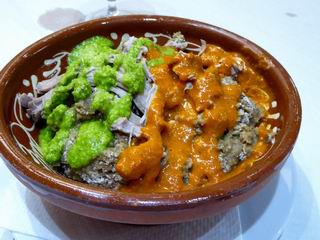
Escaldón
(savoury porridge)
& mojo |
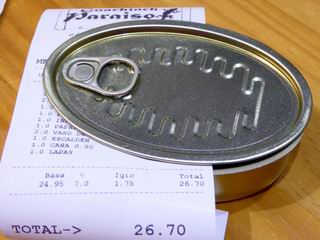
Affordable prices |
| | |
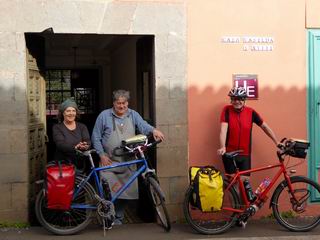
Lanchi & Manuel, Casa Casilda | The
locals are pretty relaxed, as well as very friendly and helpful. This is also reflected in their driving habits, making Tenerife an ideal
cycling destination. It’s obviously no secret, as the place is
swarming with international racing cyclists training for their summer
competitions. We didn’t meet any other packed bikes, so Kurt felt somewhat unique among the 5 million tourists Tenerife hosts annually! |
| |
